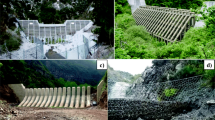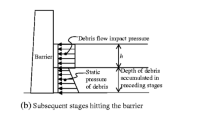Abstract
Windborne debris is one of the most important causes of the envelop destruction according to the post-damage investigations. The problem of windborne debris damage could be summarized as three parts, including windborne debris risk analysis, debris flying trajectories, and impact resistance of envelope analysis. The method of debris distribution is developed. The flying trajectories of compact and plate-like debris are solved by using a numerical method according to the different aerodynamic characteristics. The impact resistance of the envelopes is also analyzed. Besides, the process of windborne debris damage analysis is described in detail. An example of industrial building is given to demonstrate the whole method by using the observed data of typhoon Chanchu (2006). The method developed in this paper could be applied to risk assessment of windborne debris for structures in wind hazard.
Similar content being viewed by others
References
Minor J E. Lessons learned from failures of the building envelope in windstorms. Journal of Architectural Engineering, 2005, 11(1): 10–13
Wills J A B, Lee B E. Vulnerability of fully glazed high-rise buildings in tropical cyclones. Journal of Architectural Engineering, 2002, 8(2): 42–48
Lin N, Holmes J D, Letchford C W. Trajectories of wind-borne debris in horizontal winds and applications to impact testing. Journal of Structural Engineering, 2007, 133(2): 274–282
Wills J A B, Lee B E, Wyatt T A. A model of wind-borne debris damage. Journal of Wind Engineering and Industrial Aerodynamics, 2002, 90(4–5): 555–565
Tachikawa M. Trajectories of flat plates in uniform flow with applications to wind-generated missiles. Journal of Wind Engineering and Industrial Aerodynamics, 1983, 14(1–3): 443–453
Holmes J D. Trajectories of spheres in strong winds with application to wind-borne debris. Journal of Wind Engineering and Industrial Aerodynamics, 2004, 92(1): 9–22
Vickery P J, Lin J, Skerlj P F, Twisdale L A, Huang K. HAZUS-MH Hurricane model methodology. I: Hurricane hazard, terrain, and wind load modeling. Natural Hazards Review, 2006, 7(2): 82–93
Behr R A, Minor J E. A survey of glazing system behavior in multistory buildings during Hurricane Andrew. Structural Design of Tall Buildings, 1994, 3(3): 143–161
Author information
Authors and Affiliations
Corresponding author
Rights and permissions
About this article
Cite this article
Song, F., Ou, J. Windborne debris damage prediction analysis. Front. Archit. Civ. Eng. China 4, 326–330 (2010). https://doi.org/10.1007/s11709-010-0067-5
Received:
Accepted:
Published:
Issue Date:
DOI: https://doi.org/10.1007/s11709-010-0067-5




